Invasive breast cancer is when the cancer cells break out from inside the lobules or ducts and invade nearby tissue, spreading to other parts of the body.

‘Signature 3 might one day factor into treatment decisions for women with breast cancer, or help guide development of future "BRCAness"-targeting therapies.’





The question is, what else might deactivate HR and give rise to Signature 3? And beyond that, might Signature 3 have a role in the clinic? To find out, an international team led by Paz Polak, Jaegil Kim, Lior Braunstein, and Gad Getz of the Broad Institute's Cancer Program and William Foulkes of McGill University reanalyzed data from nearly 1,000 breast cancer tumors collected by The Cancer Genome Atlas (TCGA). Their findings, reported in Nature Genetics, hint that mutational signatures like Signature 3 might fuel a precision medicine approach that uses a tumor's full scope of mutations to guide risk and treatment decisions, instead of focusing on individual genes.
Among the breast tumors exhibiting Signature 3, the researchers found that:
Tumors with germline (inherited) or somatic (acquired) BRCA1 or BRCA2 mutations were overwhelmingly positive for Signature 3. So too were tumors with germline mutations in PALB2, a gene that works in concert with BRCA1 and BRCA2.
Defects in ATM or CHEK2 (two genes that alert the cell to DNA damage, and which can harbor breast cancer risk-raising germline variants) were not linked to Signature 3.
Advertisement
And what of Signature 3's clinical utility? The team found that they could combine the signature's presence or absence in breast cancer cells with other data to classify rare BRCA1 and BRCA2 mutations as harmful or not, a finding they noted needs to be investigated further. The researchers also suggested that Signature 3 might one day factor into treatment decisions for women with breast cancer, or help guide development of future "BRCAness"-targeting therapies.
Advertisement















